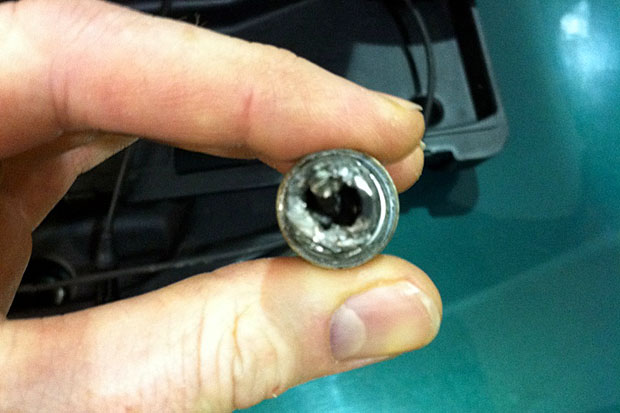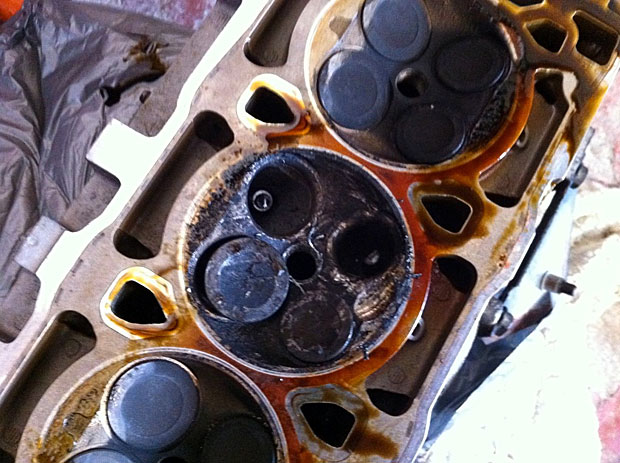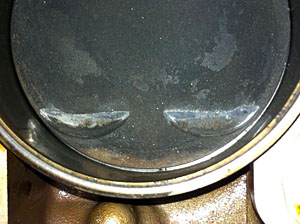February's cold weather results in a serious problem for Alastair's Elise.
When I started this blog I got a lot of hilarious comments on Twitter, most of which included the well-known LOTUS acronym Lots Of Trouble Usually Serious). However, given that I was starting from a point with two years’ preventative maintenance and TLC having been lavished upon the car, I was quietly confident I would prove the old adage wrong. Especially (in a perverse roundabout fashion) since my car had led a relatively hard life to date, so any big issues should have been flushed out already. Right? Wrong.
In February my otherwise flawless hypothesis suffered a minor setback. Actually, if I’m completely honest, ‘minor’ is about as far from the truth as you can get. This was as serious a problem as they come and ultimately marked the end of a big chapter in the Elise’s life.
The Elise is dead
As you may remember February was a very cold month, with temperatures hitting -12˙C on more than one occasion. This caused a few issues with the battery in the family Toureg, meaning I needed to move the Elise in order to jump-start the big wagon. Miraculously (see my previous battery woes) the Elise started first time, but it sounded a little odd. It felt like a return of an issue where the backbox vibrated against the bodywork, but then the noise turned into a serious metal-on-metal banging noise once I’d got out of the car to check properly.
As the noise grew louder and the idle got lumpier I realised all was not well, but before I could switch the car off the engine died. Nothing violent. No histrionics. Certainly not the way I envisaged my engine expiring at all. At this point you’ll probably be wondering how the engine can be considered dead simply from running at idle. Well, I can thank the AA for that little ‘enhancement’.
A couple of days after the engine died, I called the AA to get a tow to my local specialist. I was adamant that the problem with the car was serious and told both the telephony agent and the patrolman it could be timing/cambelt-related. To be honest, I didn’t have a clue but thought it better to be prudent. However, for some unknown reason once on site I let the patrolman convince me that the engine had flooded at the time and now the non-starting issue was due to a faulty starter motor.
As I write this now, I’m cringing at how stupid I was, but at the time I guess I wanted it to be an easy fix and since it was a couple of days after the event, a little self-doubt had wormed its way into my theories.
Anyway, after an aggressive hill bump start, a lot of nasty crunching noises and some choice cursing, I had my 40 minute tow and was parked up at trusty PSR Automotive. Somewhat ironically, the only driving I’d done in the Elise since it was last there was the trip home from the garage! A couple of days later I got an ominous message from PSR containing the words “Initially looks serious, although inconclusive yet”, followed by a couple of pictures…

The follow-up conversation was more descriptive, but no less chilling: “It appears there has been a total disintegration of the block; you can see across all cylinders and number two piston is currently located in the sump.” Now, I’m no expert but this didn’t sound good. Perhaps most upsetting was that it quickly became apparent that my £1.5k+ Vulcan head was pretty much destroyed, or at least beyond economical repair. As you can see from the photos it looks like one hell of a mess.


As I mentioned above and as the photos clearly show, cylinder two was clearly where the party got out of control but there also appear to be marks on all of the other pistons where the inlet valves have been catching them. This would suggest a long-running issue, either by regular over-revving past the limiter (most likely on down-change) or a mis-setting of the vernier pulleys.

I’m as confident as I can be that it hasn’t been regularly over-revved in the last five years or so, so it’s possible that the cause may have been someone else’s poor workmanship. The timing was set up by Dave Andrews at DVA Power in November 2009, and the car was rolling-roaded again in November 2010 by TCS Performance. Both have good reputations (Dave especially) so it’s unlikely that they caused the issue, although I guess mistakes do happen.
There’s a few things that with hindsight could have been warning signs of the problem, but to be honest, the only way I would have known for sure is if I’d had the engine stripped down at great cost. Such pre-emptive maintenance sounds like a great idea in retrospect, but given the cost, it wasn’t on the cards for the foreseeable future. Besides, unless you’re a compulsive tinkerer, how frequently do you perform that sort of maintenance on your car?
Long live the Elise
Once I’d got my head around the calamitous bad news, it was clear that I had some big decisions to make. I love the car, it’s had hundreds of hours of TLC and lots of cash poured into it to look after it, and in return it’s treated me to many a cracking trackday. Coupled with this is the fact that the S1 Elise is a proper modern classic. I have visions of my kids growing up with this car. What else at this price bracket is as special and meets my needs so well? If I did replace it, what would I replace it with?
I decided to take the approach of 'out of every challenge comes opportunity'. After all, when I bought the car I did have vague thoughts of an engine swap one day. Was this the opportunity I’d been looking for? After deliberating over a multitude of options (such as buying and stripping cars for parts or selling the car completely and buying something else), I came up with the following shortlist. Predictably there were varying levels of 'opportunity' to be spent had.
-
Drop in a standard (140bhp) or uprated (140-180bhp) K-series engine
- Provenance: The basic swap maintains purity
- Weight: N/A
- Power: Likely result in a loss in power from where I started or even power at best
- Reliability: K-Series reliability would always remain a question
- Cost: Offsetting all of this is the obvious cost benefit, since this is the cheapest option in the short term [£1.5-2k]
-
Replace with a 2ltr Duratec (170-180bhp)
- Replacing with a Ford lump is, on paper, a very sensible long term option
- Reliability: It should have solid reliability and cheap parts for a long time to come
- Provenance: No idea but will become more common and should be reversible
- Weight: Not supposed to be significantly greater [retains Elise gearbox]
- Power: Likely to be on a par or up to 20bhp more
- Tunability: Not easy (read expensive) so the options of future upgrades are less obvious
- Cost: Cost of the conversion itself isn’t cheap – so it’s a lot to pay for 'just' reliability. [£5k]
-
Go all out and fit a Honda Civic Type R engine (200-230bhp+)
- Cost: Choice 3 is not cheap. In fact you may wish to refer to the original purchase price for a point of reference! However, it does cover a lot of bases
- Weight: Should be on a par with the standard Elise weight [750kgs max]
- Reliability: Bombproof reputation
- Power: 230+bhp
- Tuneability: Numerous options, although again not cheap
- Provenance: Well-trodden path and fully reversible
- Other: Six-speed 'box improves acceleration and usability, fuel economy rises to around 40mpg but wear and tear on parts such as CV joints and bushes will increase. There’s likely to be a commensurate rise in spend associated with 'must have' parts such as seats, harnesses and harness bar, uprated brakes, new radiator…
Opinions from knowledgeable friends ranged far and wide, but the consensus was as follows: “The K-swap is the most cost-effective option in the short term, but you’ll be forever wondering ‘what if’ and assuming you look to match your previous power it’s only a matter of time before it blows up again. The Duratec is probably the most sensible option, good power and great reliability. The Honda is a ridiculous option, it’s outrageously costly and who really needs all that power?”
Last month, I wrote that the Elise is not a sensible car. Decisions are not made by the head but rather the heart where this car is concerned, so it’s rarely a straightforward black and white choice. As you might expect, after much deliberation, mulling over the options and considering all the sensible advice to fit a Duratec motor, I ignored everyone and chose the Honda option. Heart not head, remember?
The following weeks involved a lot of stressing about the cost, and deciding what route to go for the conversion. This is a blog update in its own right, so I’m going to save that for next time. However, I will finish this post with a few stats taken from hondaelise.com. After all, this month’s post has been lighter in the numbers department than usual!
A Euro-spec K20A2 i-VTEC engine should output about 220-230bhp and 157ft/lb torque when fitted with an induction kit, exhaust manifold and K-Pro & remap.
Performance stats:
- 0-60 4 seconds
- 0-100 9.5 seconds
- Top speed 160+mph
- Over 40 MPG fuel consumption, more frugal than 1.8 K series
Gear Ratios UK- Euro Spec. K20A2 i-VTEC Type R trans: Final drive: 4.764:1 No LSD
- 1st 3.267 : 1 @ 8000 rpm 36 mph
- 2nd 2.130 : 1 @ 8000 rpm 56 mph
- 3rd 1.517 : 1 @ 8000 rpm 79 mph
- 4th 1.147 : 1 @ 8000 rpm 104 mph
- 5th 0.921 : 1 @ 8000 rpm 130 mph
- 6th 0.738 : 1 @ 8000 rpm 162 mph
Weight Distribution pre-Honda conversion (kg)
- Left Front - 133.0
- Left Rear - 220.5
- Right Front - 149.5
- Right Rear - 216.0
- Front - 282.5 (39%)
- Rear - 436.5 (61%)
Total curb weight: 719.0kg
Weights Distribution post-Honda conversion (kg)
- Left Front - 134.0 (- 1 )
- Left Rear - 227.5 (+ 7.5 )
- Right Front -151.0 (+ 2 )
- Right Rear -222.5 (+ 6.5 )
The actual weight distribution is exactly the same.
- Front - 282.5 (39%)
- Rear - 450.0 (61%)
- Total curb weight - 735.0kg
I’m having the Elise weighed and corner-weighted before and after the conversion, as well as a session on a rolling road, so I’m keen to see how close we get to these figures above. Regardless, as long as we’re in the same ballpark it should be rocketship quick. And all that power will be in a car with no ABS, power steering, airbags, traction control or a fixed roof. Brilliant! Every cloud and all that….

